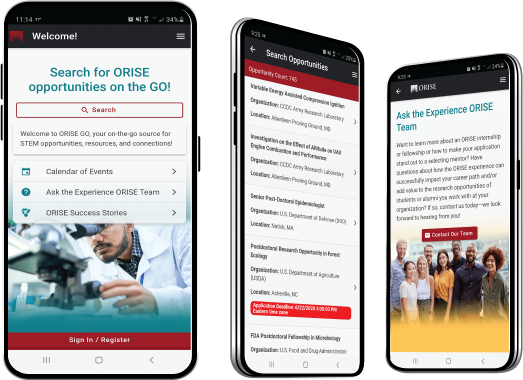Novel Detection Methods: Counterfeit Identity Documents Fellowship
Create and release your Profile on Zintellect – Postdoctoral applicants must create an account and complete a profile in the on-line application system. Please note: your resume/CV may not exceed 2 pages.
Complete your application – Enter the rest of the information required for the IC Postdoc Program Research Opportunity. The application itself contains detailed instructions for each one of these components: availability, citizenship, transcripts, dissertation abstract, publication and presentation plan, and information about your Research Advisor co-applicant.
Additional information about the IC Postdoctoral Research Fellowship Program is available on the program website located at: https://orise.orau.gov/icpostdoc/index.html.
If you have questions, send an email to ICPostdoc@orau.org. Please include the reference code for this opportunity in your email.
Research Topic Description, including Problem Statement:
Limiting the use of fraudulent identities is critical to protect US infrastructure and to prevent large scale financial fraud, like the schemes that skyrocketed due to the COVID pandemic and recent natural disasters. The fraud is both domestic and international, born of greed and of efforts to destabilize the United States. The tools are stolen identities, and corresponding counterfeit licenses from the 50 states, as well as passports from around the globe. Data is critically needed to assess the validity of fabricated documents to prevent widespread fraud.
A few decades into the implementation of machines being able to authenticate identity documents called machine authentication have produced some valuable lessons. The primary lesson is that the task is tremendously difficult. Assessment of design features and security features had not been sufficiently accurate. The accuracy was improved by incorporating the review of steganographic and encrypted data. This places the human interrogator of documents at a disadvantage. It’s clear that if a machine can’t detect all the counterfeit documents, then how would a human? One answer is that, as document designers and users, it’s unclear what is significant and detectable in a security document. Questioning users reveals that “the color is wrong” or “it feels wrong” are typical explanations for rejecting a document.
This kind of knowledge is gleaned with experience and quickly shared with users. It’s regularly incorrect, for example: [in reference to a specific state license] “it’s always fake if they are smiling since they aren’t allowed to smile”. Rather than relying on the user to use anecdotal data to develop methods to assess documents, it is critical to develop actual data. There has been no systematic attempt to determine the existence of novel detection methods by assessing production error rates, wear anomalies and less obvious characteristics. This proposal calls for a comprehensive review of the physical characteristics of document substrates, document printing, security features and issuance processes used for US identification document and other securely produced documents. The breadth of information regarding identification documents has been expanded. Further expansion would permit heretofore unutilized assessment methods.
Among other forensic and intelligence functions, the forensic assessment of domestic and international travel and identity documents is the purview of the Homeland Security Investigations Forensic Lab (within DHS). The Forensic Lab is the only ANAB (ANSI National Accreditation Board)-accredited laboratory in the US tasked with forensic examinations of international travel and identity documents. In support of those forensic examinations, the lab is staffed by bench forensic examiners, as well as physical scientists, and has a variety of scientific equipment, including Video Spectral Comparator (VSC), Digital X-Ray, Digital Microscope, X-Ray Fluorescence Spectroscopy (Micro-XRF); SEM/Energy Dispersive Spectroscopy (EDS); Fourier-transform Infrared Spectroscopy (FTIR); Gas Chromatography/Mass Spectrometry (GCMS); Laser Ablation Inductively Coupled Plasma MS (LA-ICP/MS); Laser Induced Breakdown Spectroscopy (LIBS).
It is expected that data resulting from this research will be appropriate for journal publication or presentation at a professional meeting.
Example Approaches:
Utilize various imaging techniques (for example, digital x-ray) to image identity documents and examine whether genuine document exemplars are distinct from counterfeit identity documents.
Consider novel uses of laboratory instrumentation, augmented by artificial intelligence, to distinguish between genuine, counterfeit and altered identity documents.
Relevance to the Intelligence Community:
Develop/enhance remote retrieval of biometric, identity, signatures, geospatial, and other data across multiple settings.
Key Words: identity, counterfeit, passport, driver’s license, document personalization, secure documents, forensics analysis
Postdoc Eligibility
- U.S. citizens only
- Ph.D. in a relevant field must be completed before beginning the appointment and within five years of the application deadline
- Proposal must be associated with an accredited U.S. university, college, or U.S. government laboratory
- Eligible candidates may only receive one award from the IC Postdoctoral Research Fellowship Program
Research Advisor Eligibility
- Must be an employee of an accredited U.S. university, college or U.S. government laboratory
- Are not required to be U.S. citizens
- Citizenship: U.S. Citizen Only
- Degree: Doctoral Degree.
-
Discipline(s):
- Chemistry and Materials Sciences (12 )
- Communications and Graphics Design (4 )
- Computer, Information, and Data Sciences (17 )
- Earth and Geosciences (21 )
- Engineering (27 )
- Environmental and Marine Sciences (14 )
- Life Health and Medical Sciences (45 )
- Mathematics and Statistics (11 )
- Other Non-Science & Engineering (2 )
- Physics (16 )
- Science & Engineering-related (1 )
- Social and Behavioral Sciences (30 )

 ORISE GO
ORISE GO

The ORISE GO mobile app helps you stay engaged, connected and informed during your ORISE experience – from application, to offer, through your appointment and even as an ORISE alum!





